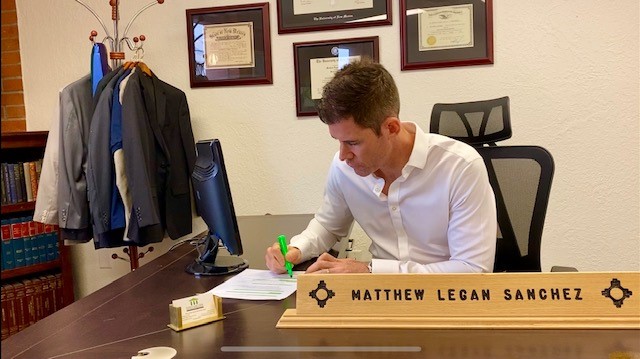
A restraining order can hurt your divorce or child custody case
RESTRAINING ORDERS DURING DIVORCE IN ALBUQUERQUE
I have a two handed — love/hate — relationship with Order of Protections (i.e. Restraining Orders). On one hand – Restraining Orders provide essential protection against household members that pose an immediate threat of harm, based on a clear Act of Abuse taking place (e.g. physical harm, severe emotional abuse, harassment, damage to property, etc.). In this hand, a valid Restraining Order establishes severe repercussions for violations, including 364 days of potential incarceration for the first offense and/or a hefty fine.
Restraining Orders provide the protected party with the ability to call APD if the Order is violated (i.e. if the abuser comes within 100 yards, attempts contact, or otherwise violates the Order). At a minimum, a violation of the Order should result in the abuser being arrested, remanded to the Metropolitan Detention Center, forced to post bail, and then hire an attorney to navigate the forthcoming criminal charges that will flow through the Metropolitan Court. In other words, the Order provides abusers with immense incentives to stay away and stop future abuse.
The protections outlined above are vital for abused individuals, establishing essential safeguards to protect one from an immediate threat of harm.
With that said, the discussion above only covers one hand. On the other hand — the Order of Protection process is routinely abused and manipulated for retaliation, harassment, or leverage for custody and divorce cases. Because it is free of charge to file and serve the Order of Protection – at times – the system is abused.
Here are some of the common ways that I see the invaluable Order of Protection process manipulated when the parties are seeking a divorce.
TEMPORARY ORDER OF PROTECTIONS CAN FORCE ONE PARTY OUT OF THE MARTIAL RESIDENCE DURING A DIVORCE
At times a relationship has soured and a divorce looms on the horizon like a dark cloud threatening a special occasion. Because both parties are generally on either the lease or the mortgage, both parties have a right to remain in the home when the relationship breaks down and eventually spills over into divorce.
The marital residence also functions as the nucleus for the children’s lives, establishing a home base for normalcy. Because of this fact, a parent that elects to move out of the marital residence, leaving the children with the other parent, unwittingly establishes a “status quo” of the remaining parent essentially having primary custody over the children. This status quo follows both parties through the divorce, and the eventual parenting plan that establishes ongoing time-sharing.
Because one spouse generally is unable to force the other spouse out of the home, at times one spouse will claim that an act of abuse occurred and that they are in danger of an immediate threat of harm. A Restraining Order is filed and a temporary order is entered. This temporary order in turn forces one party out of the marital residence until a hearing is held – by statute within 10 days.
With one party now out of the home, the remaining party at times will change the locks before a Petition for Divorce is filed, and a Temporary Domestic Order is entered that prevents the parties from making unilateral changes and freezes the status quo. With one parent out of the marital residence, and the children in the home, the act also creates a status quo where the remaining parent becomes the primary care giver of the children – even when the temporary order does not prevent one parent from contacting the children.
In turn, the temporary order can create a status quo that follows the parties into the future.
TEMPORARY ORDERS CAN BE USED TO GAIN AN ADVANTAGE IN DIVORCE AND CHILD CUSTODY CASES
As we’ve seen temporary orders can be used to force one party out of the marital residence. This act can in turn affect the status quo and time-sharing with the minor children. Assuming that an Order of Protection is eventually entered, the DV Commissioner will have jurisdiction for six months to determine the temporary system of time-sharing. Eventually a Petition for Divorce will be filed, and the matter will go before the DM Judge for a more permanent time-sharing schedule. Nevertheless, the time-sharing first established by the temporary order, and possibly a subsequent order entered by the DV commissioner, can follow the parties down-stream into the DM case. Because of this fact, at times, one spouse will use the Restraining Order process in an attempt to gain leverage with time-sharing by establishing a status quo of one parent having primary custody over the children.
This status quo can follow the parties downstream, affecting the long-term and ongoing time-sharing schedule that will eventually materialize through a Parenting Plan in the DM case.
RESTRAINING ORDER USED AS RETALIATION FOR A DIVORCE
Restraining Orders are routinely used in retaliation for the relationship crumbling and one party proposing divorce.
New Mexico is a no-fault state and either party to the marriage can request a divorce at any time – assuming that the parties have lived in NM for 6 months and the court has jurisdiction (power). Usually a party claims “irreconcilable differences” which basically means “we can’t get along.”
Sometimes both parties don’t want the divorce. In some occasions, one party will drag their feet on the process, in an attempt to stretch out the process as long as possible. In other occasions, one party will file a Petition for Order of Protection, claiming acts that either never occurred, or happened months or years in the past. Often the person will claim harassment, emotional abuse, or threats. Sometimes these claims are completely baseless. Unfortunately, Second Judicial District Court is extremely busy with over-flowing dockets and limited time and resources. The Court generally leans on the side of caution when deciding if a Petition for Order of Protection has stated the requisite probable cause to find that an act of abuse has occurred, warranting a Temporary Order being entered. The process is not wrinkle free and some cases fall through the cracks.
Because it is free to file a Petition for Order of Protection, and to have the Order served, the process has the potential for being abused. Ironically, at times, the party that is seeking an Order of Protection based on claims of abuse or harassment, is actually using the process in an abusive or harassing manner.
(505) SANCHEZ IS HERE TO EXPLAIN HOW RESTRAINING ORDERS CAN AFFECT YOUR DIVORCE IN ALBUQUERQUE
Do you still have questions about your specific case and how restraining orders can affect your divorce in Albuquerque, New Mexico? Custody and divorce in Albuquerque often requires the experienced hand and knowledge that comes with years of courtroom practice. Matthew Legan Sanchez has the experience needed to handle your unique case. Sanchez can be reached by calling (505) SANCHEZ.

How Restraining Orders Can Affect Your Divorce in Albuquerque







